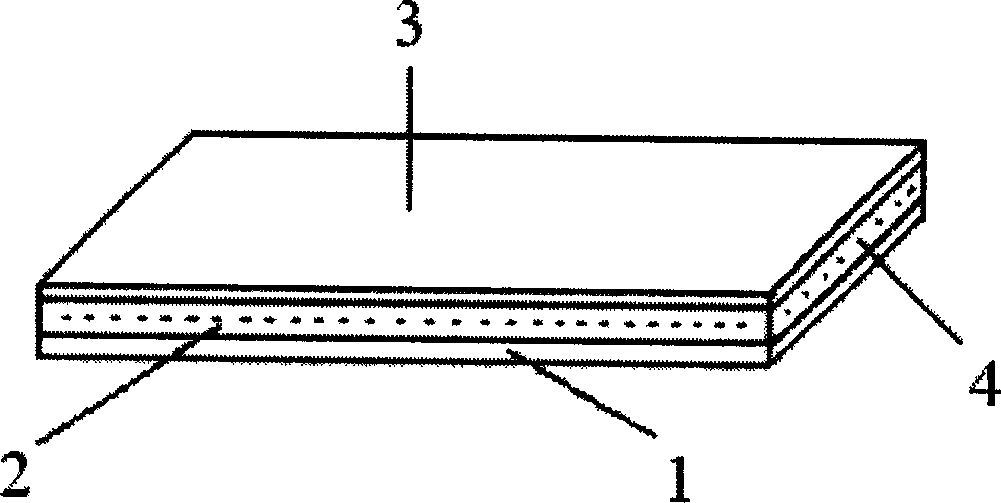Emergency wound dressing and its preparation method
A wound dressing and blank technology, applied in dressings, viscous dressings, medical science, etc., can solve the problems of poor absorption of wound exudate, easy adhesion of wound surface, poor hemostasis, etc., achieve obvious drainage effect and good adhesion , beneficial to the healing effect
- Summary
- Abstract
- Description
- Claims
- Application Information
AI Technical Summary
Problems solved by technology
Method used
Image
Examples
Embodiment 1
[0014] Example 1 Preparation of first aid wound dressing
[0015] 1. Materials:
[0016] Viscose fiber: Tangshan Sanyou Group Chemical Fiber Company, breaking strength: 1.6-2.7cN / dtex, breaking elongation: 16.0-25.0%, linear density: 1.5-1.7dtex, length: 36.0-38.0mm.
[0017] Superabsorbent resin: FAVOR SXM 100F polymer blood-absorbing agent from Stockhausen Superabsorber, the main component is sodium polypropylene cross-linked body, artificial blood absorption: 26.0-33.0g / g; particle distribution rate: 600 mesh 3 .
[0018] Chitosan fiber: Qingdao Haisheng Biological Company, breaking strength: 1.6-2.0cN / dtex, breaking elongation: 16.0-20.0%, linear density: 1.6-1.9dtex, length: 55.0-65.0mm.
[0019] Calcium alginate fiber: China Academy of Textile Sciences, breaking strength: 1.5~1.9cN / dtex, breaking elongation: 4.0~6.0%, linear density: 3.5~4.0dtex, length: 55.0~65.0mm.
[0020] Ethylene-propylene fiber: Shanghai Synthetic Fiber Research Institute, melting poi...
Embodiment 2
[0023] Example 2 Animal experiments to detect the wound adhesion effect and hemostatic effect of emergency wound dressings
[0024] 1 Wound adhesion effect test
[0025] 1.1 Materials and methods:
[0026] 1.1.1 Materials
[0027] Group A1: chitosan fiber
[0028] Group A2: the mixing ratio of chitosan fiber and alginic acid fiber is 3:1
[0029] Group A3: the mixing ratio of chitosan fiber and alginic acid fiber is 1:1
[0030] 1.1.2 Animals
[0031] Healthy rabbits, both male and female, weighing 2.0Kg to 2.5Kg.
[0032] 1.1.3 Sample preparation
[0033] Cut materials A1, A2, and A3 into 4cm×4cm size, and sterilize under high pressure at 121°C for 20 minutes before use.
[0034] 1.1.4 Wound adhesion test
[0035] Twelve rabbits were randomly divided into 3 groups, that is, groups A1, A2, and A3, with 4 rabbits in each group, two wounds in each rabbit, and a group of eight wounds. The left and right sides of the rabbit's back were sheared to 6×10 cm, and Sumianxin 0....
Embodiment 3
[0056] The clinical use effect of embodiment three emergency wound dressings
[0057] General clinical data: First aid trauma dressing was applied to 20 patients with various types of trauma, including 17 males and 3 females, aged 15-46 years, with an average of 28 years old. There were 8 cases of upper extremity trauma, 6 cases of lower extremity trauma, 4 cases of head and face trauma, and 2 cases of trunk trauma. All were fresh wounds, and 20 cases were compared with ordinary oil gauze autologous.
[0058] Materials and methods: After wound debridement, the wound was directly bandaged and fixed with adhesive tape, and the dressing was changed once a day. Observe the anti-adhesion, absorption of exudate, and anti-infection effects, and use ordinary oil gauze soaked in chloramphenicol as the same body control. The results are shown in Table 3.
[0059]
group
Observation indicators
Number of cases
Remarkable effect
good ef...
PUM
| Property | Measurement | Unit |
|---|---|---|
| length | aaaaa | aaaaa |
| length | aaaaa | aaaaa |
| length | aaaaa | aaaaa |
Abstract
Description
Claims
Application Information
 Login to View More
Login to View More - R&D
- Intellectual Property
- Life Sciences
- Materials
- Tech Scout
- Unparalleled Data Quality
- Higher Quality Content
- 60% Fewer Hallucinations
Browse by: Latest US Patents, China's latest patents, Technical Efficacy Thesaurus, Application Domain, Technology Topic, Popular Technical Reports.
© 2025 PatSnap. All rights reserved.Legal|Privacy policy|Modern Slavery Act Transparency Statement|Sitemap|About US| Contact US: help@patsnap.com

